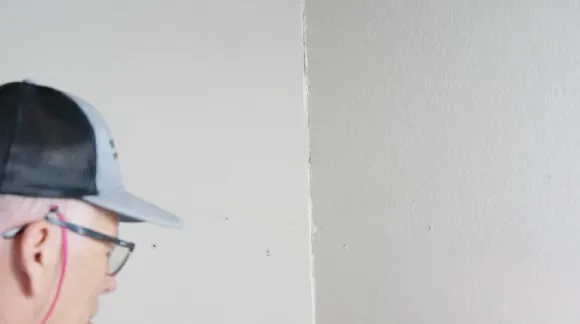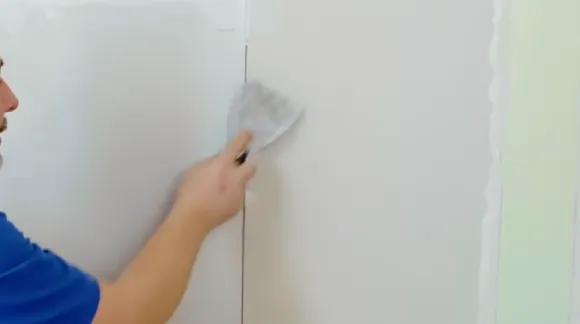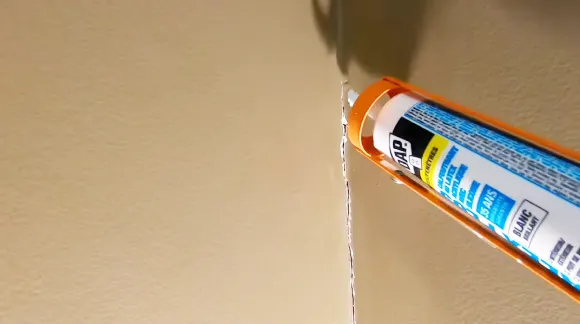Last Updated on January 25, 2023
Are you having trouble with cracks in your drywall? These corner cracks on drywall always seem to show up. Dealing with unsightly drywall cracks is a common problem for many homeowners.
Are you not sure how to fix them? With a little bit of knowledge, understanding, and effort, you can fix them yourself. Everything you need to know regarding “how to fix drywall cracks in corners?” has been clearly written in this blog post using nothing more than a few common tools and materials.
Follow these simple steps, and you will be good to go so that your walls look good as new. Keep reading for tips and advice on how to get the fixing of the cracked corners done right. Read on to learn how it has been done.
How to Fix Drywall Cracks In Corners: 2 Situations

Fixing drywall cracks is a relatively easy do it yourself project. While unsightly, these cracks are usually not a structural problem and can be easily fixed. There are a few different methods that can be used to fix drywall cracks, depending on the size and severity of the crack.
- For small cracks, using a joint compound or spackling compound can be effective. These compounds can be applied using a putty knife and then sanded smooth once they have dried.
- For larger cracks, it may be required to use mesh tape or fiberglass mesh to reinforce the area before applying the joint compound. Once the fix is complete, it is important to paint over the area to match the surrounding wall.
The Different Methods for Fixing Drywall Cracks in Corners
The first option is to use a pre mixed joint compound, which comes in a bucket and is available at most hardware stores.
Another option is to mix your own joint compound using powder and water. This method requires a little more work, but it can save you money in the long run.
For small cracks less than 1/4 inch wide, use a corner bead and mesh tape. For larger cracks over 1/4 inch wide, use fiberglass mesh tape.
- First, cut the corner bead to fit the length of the crack.
- Second, apply a joint compound layer to the back of the corner bead.
- Third, position the corner bead over the crack and press it into place.
- Fourth, coat a layer of joint compound over the corner bead.
- Fifth, embed the fiberglass mesh tape into the wet joint compound.
- Sixth, apply a second coat of joint compound on top of the tape.
- Finally, let the joint compound dry completely before painting or sanding. Sanding should only be necessary if there are ridges or bumps on the surface of the joint compound.
These fixes will improve both the appearance and strength of your drywall corners. Whichever method you choose, fixing drywall cracks in corners is a relatively easy process that anyone can do. With a little time and effort, you can have your drywall looking like new again.
What Tools are Needed To Fix Drywall Corner Cracks?

If you have a drywall corner cracking, don’t despair. With the right tools and supplies, you can easily fix it yourself. Here’s what you’ll need:
A putty knife
Use a putty knife and a wall fix kit, which is available at any hardware store. The kit contains a drywall patch, joint compound, and sandpaper. To begin, use the putty knife to apply the joint compound to the crack, starting at the top and working your way down.
Then apply additional joint compound with the putty knife to ensure that the drywall patch covers the crack completely. After the fix has been made, smooth the area around it using sandpaper.
A mud pan
Mud pans are an essential tool when fixing drywall corners. The pan allows you to hold a larger quantity of mud, which is necessary for filling the crack. It also provides a stable surface on which to work, and the wide lip helps to prevent the mud from spilling.
The mud pan can be used to create a clean, straight edge when applying mud to the wall. This is especially helpful when fixing cracks that run along the edge of a room. As a result, the mud pan is an essential tool for any do it yourselfer who wants to fix drywall corners.
Drywall joint compound (also called mud)
Drywall joints are weak spots in your walls that are susceptible to cracks, especially in the corners. While small cracks can be fixed with tape, larger cracks will require a joint drywall compound. This compound is spread over the crack and then covered with tape or mesh.
This helps to hold it in place while it dries. Once dry, the compound will create a strong bond that will help to prevent future cracking. The joint compound will also help to smooth out any roughness around the edges of the crack, creating a seamless fix.
A 6 inch drywall knife

A 6 inch drywall knife is the best tool for fixing a drywall corner crack because it provides the necessary leverage to push the mud into the crack without damaging the surrounding area. The blade of the knife also helps to evenly distribute the mud so that the fix is less likely to show through once it dries.
A 6-inch knife gives you more control over the fix process so that you can avoid making a bigger mess than necessary. So, if you’re looking to make a quick and professional fix to a drywall corner crack, reach for a 6 inch drywall knife.
Fine grit sandpaper
Use fine grit sandpaper to smooth out the area around the crack. This will create a smooth surface for the fixed patch. Once you have sanded the area, you can then apply a patch to the cracked drywall.
The patch should be slightly larger than the actual crack. Once the patch is in place, you will want to smooth out the edges with fine grit sandpaper. This will help to create a seamless fix.
A damp sponge
Dampen a sponge with water and apply it to the crack. The reason for this is that the sponge will help to rehydrate the drywall so that it can be fixed more easily. After applying the sponge, leave it in place for several minutes to allow the drywall to absorb moisture.
A vacuum cleaner with a hose attachment
Attaching a hose to your vacuum cleaner is important because it allows you to reach the crack easily and get rid of all the dirt and dust that has accumulated there. If you don’t have a hose attachment, you will have to use a brush to clean the crack, which can be very time consuming.
How to Identify Drywall Crack Types, and What do they Mean?

Different types of cracks in drywall can indicate different problems with your home’s structural integrity. Here are some common types of cracks and what they might mean:
- Hairline cracks are the most common type of drywall crack. They are usually caused by changes in temperature or humidity, and they don’t typically indicate any serious problems. Seeing a lot of hairline cracks might be a sign that your home is not well-insulated, which can lead to higher energy bills.
- Large cracks (larger than 1/4 inch) can be caused by the settlement of foundations or shifting walls. If you see large cracks, you should have a professional inspection to determine the cause and make sure that your home is still structurally sound.
- Stair step cracks are usually caused by movement in the foundation or framing of your house. These types of cracks can be serious, so you should have an inspection if you see them.
- Cracks that start at the corner of a window or door frame are called “settlement cracks.” They are caused by the settling of your home’s foundation and can be an indication of serious structural problems.
What are Some Economic Ways to Fix Drywall Cracks?
There are a few economical ways to fix drywall cracks based on their severity and type. Superficial cracks, or those that are smaller than 1/4 inch wide, can be fixed using putty or spackle.
The first step is to clean out the crack using a vacuum cleaner or a brush to remove any loose dirt or debris.
Apply the putty or spackle to the crack and smooth it over with a putty knife. Once dry, the area can be painted to match the rest of the wall.
For cracks that are deeper or wider, it may be necessary to use a drywall patch. These patches are easily found at most home improvement stores and home improvement centers.
To apply the patch, simply place it over the hole and secure it in place with drywall tape or screws. Once in place, the patch can be sanded smoothly and then painted to match the surrounding area.
Drywall Cracks Forming Long Term Preventing Solutions

Drywall is a popular material for interior walls and ceilings, thanks to its affordability and ease of installation. Drywall is also susceptible to cracking, especially in areas where there is significant weight or movement.
It is best to prevent drywall cracks from occurring in the first place rather than fix them once they have occurred. The most important thing to do is to make sure that the drywall is properly supported.
This means using strong beams and screws when installing the drywall and reinforcing any areas that are likely to experience stress or movement. Applying a sufficient amount of joint compound when finishing the drywall is most important.
How Does Climate Affect Drywall Cracking and Mitigate Potential Damage?
Climate can have a significant effect on drywall cracking. In general, hot and dry conditions are most likely to cause problems, as the lack of moisture can cause the gypsum in the drywall to shrink and crack.
Cold temperatures can also lead to cracking, as the water in the gypsum expands and puts pressure on the wall. There are a few things that can be done to help prevent or mitigate damage from climate change.
First, it is important to maintain consistent indoor humidity levels, as this will help to prevent gypsum from drying out. Second, try to avoid sudden changes in temperature, either by using a gradual heating/cooling system or by insulating the home against extreme swings in temperature.
If you take these precautious steps, then you will be able to ensure that your drywall will remain crack free for nearby future.
What are the Different Types of Drywall Cracks that can Form?

Drywall is a type of wallboard used to finish interior walls and ceilings. Two thick sheets of paper are sandwiched between panels of gypsum plaster.
Drywall is also known as plasterboard, wallboard, sheetrock, or gypsum board. It is commonly used in construction and home renovation because it is easy to install and provides a finished look. There are three main types of drywall: regular, fire resistant, and waterproof. Each type has different characteristics and benefits.
Regular drywall is the most common type used in homes. It is made of an inner layer of gypsum covered by a paper liner. Fire resistant drywall is treated with chemicals to help it resist fire. Waterproof drywall is made with a waterproofing compound that helps it resist moisture.
Cracks can form in drywall for many reasons, including settling foundations, thermal expansion and contraction, poor installation, and impact from earthquakes or high winds. The most common type of crack is the horizontal crack, which runs parallel to the ceiling or floor joists.
A vertical crack runs up and down the wall and can be caused by settlement or poor installation. Diagonal cracks occur when there is movement at the corners of the wall or doorways. These are often brought about by settling foundations or damage from high winds or earthquakes.
Ceiling cracks can be caused by thermal expansion and contraction, settling foundations, or poor installation. Some cracks are superficial and do not affect the structural integrity of the wall, while others are more serious and may require fixes.
Conclusion
We hope you found this post helpful in understanding the varying types of drywall cracks, what causes them, and how to best address them. While some cracks can be fixed relatively easily and cheaply, others may indicate more serious problems with your home’s structure.
If you have any further questions or would like help assessing the damage to your drywall, please do not hesitate to contact us. In the meantime, stay safe and dry out there.
Related Article:



